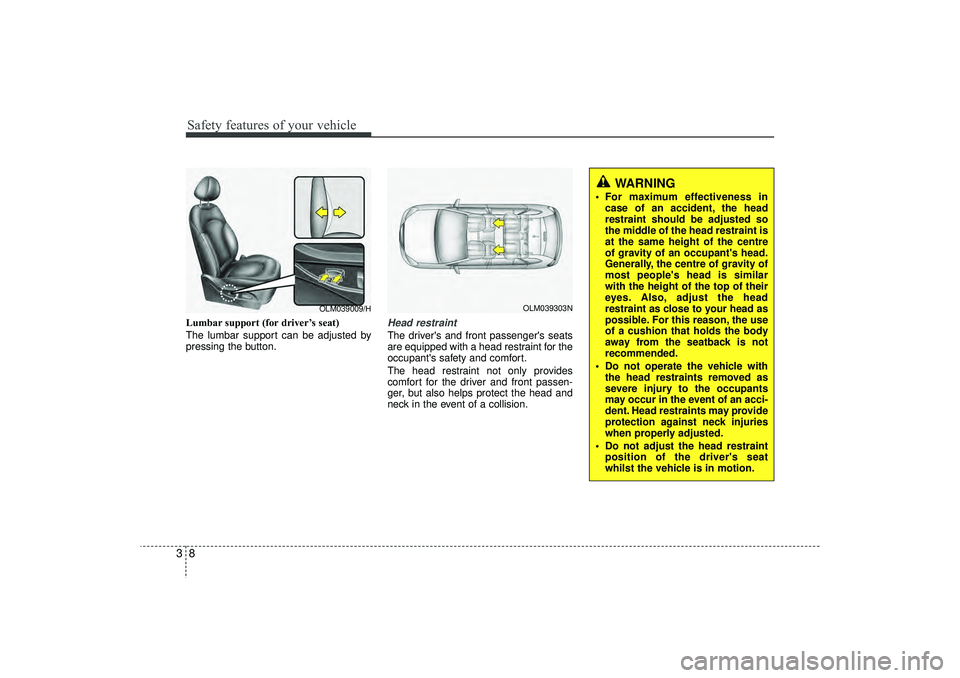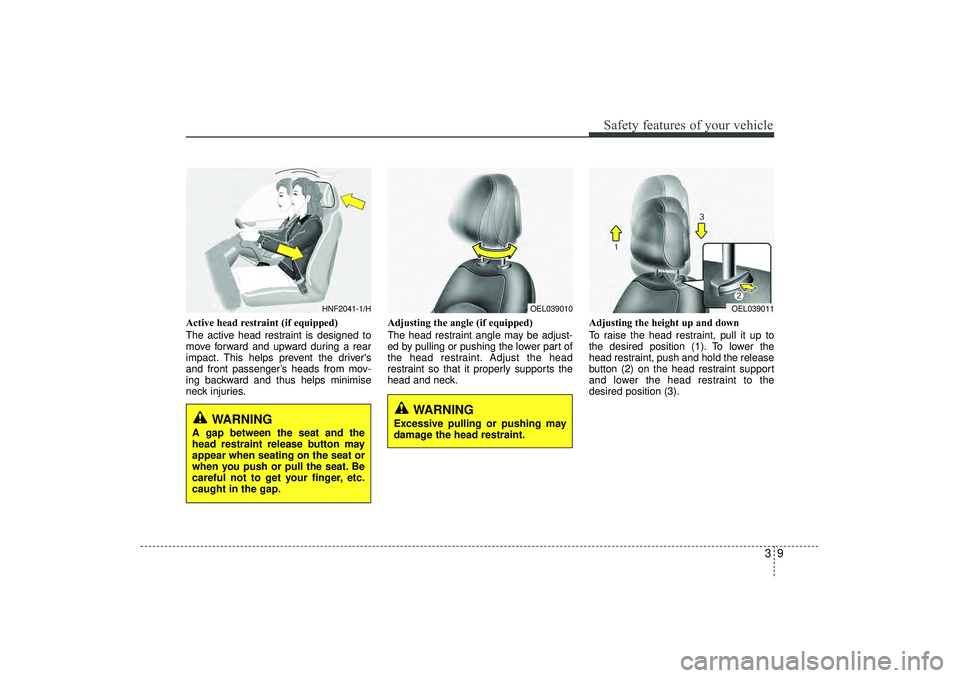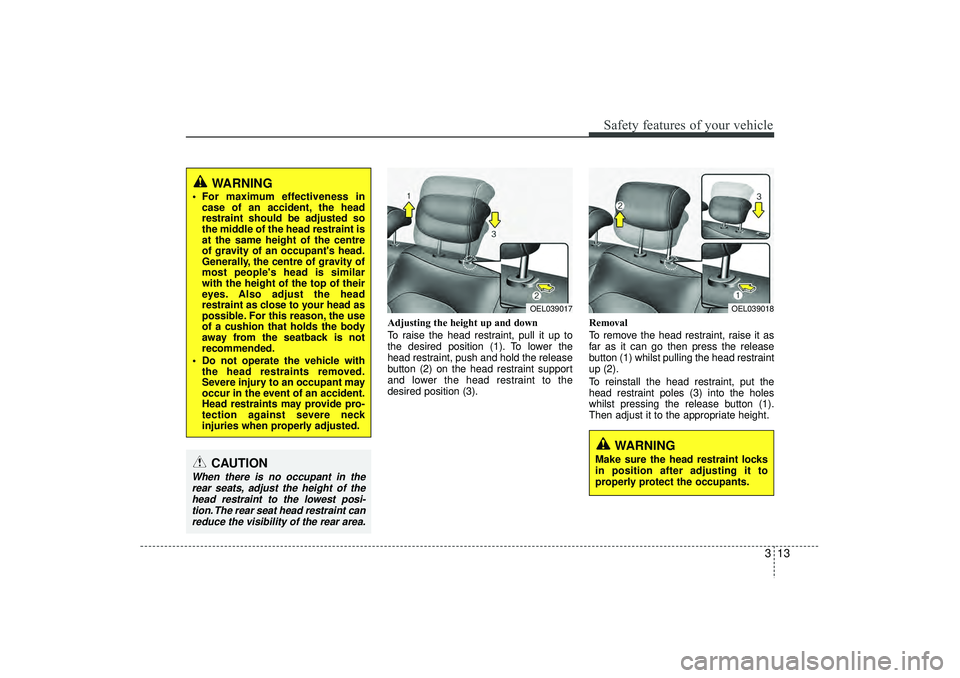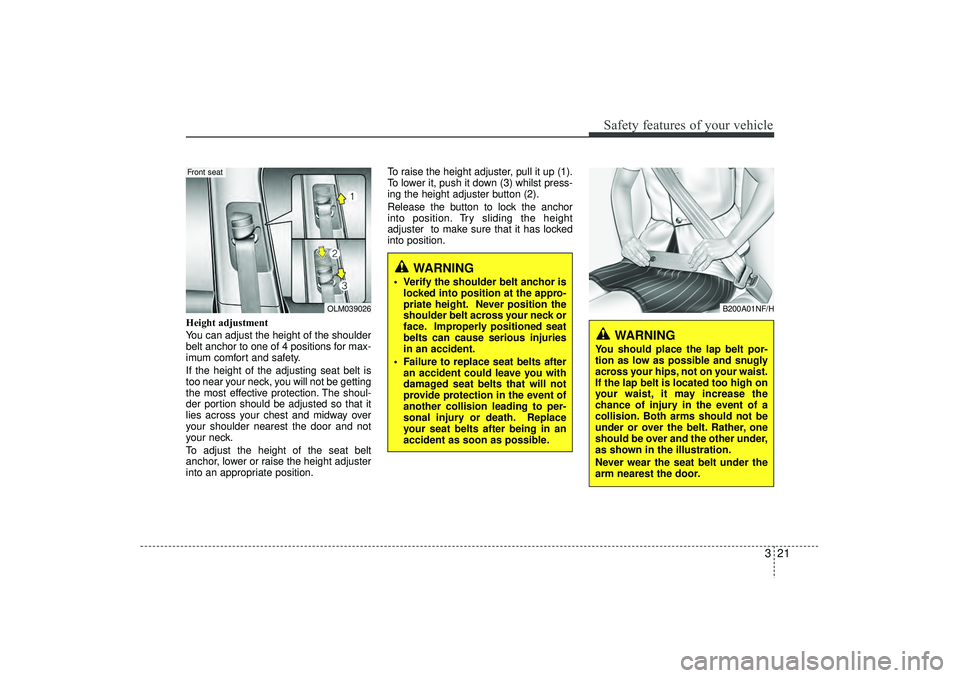Page 21 of 550
Safety features of your vehicle23
Front seat(1) Forward and backward
(2) Seatback angle
(3) Seat cushion height (Driver’s seat)
(4) Lumbar support (Driver’s seat)*
(5) Seat warmer*
(6) Head restraintRear seat(7) Seatback folding
(8) Head restraint
(9) Armrest
(10) Seat warmer*
* if equipped
SEAT
OEL039001R
EL(FL) UK 3.QXP 12/16/2014 8:54 PM Page 2
Page 24 of 550
35
Safety features of your vehicle
Front seat Manual adjustment Forward and backward
To move the seat forward or backward:
1. Pull the seat slide adjustment lever upand hold it.
2. Slide the seat to the position you desire.
3. Release the lever and make sure the seat is locked in place.
Adjust the seat before driving, and make
sure the seat is locked securely by trying
to move forward and backward without
using the lever. If the seat moves, it is not
locked properly.
Adjusting the seatback reclinerTo recline the seatback, rotate the knob
forward or rearward to the desired angle. Seat cushion height
(for driver’s seat, if equipped)
To change the height of the seat cushion,
push the lever upwards or downwards.
To lower the seat cushion, push down
the lever several times.
To raise the seat cushion, pull up the lever several times.
OEL039003/H
OEL039004/H
OEL039002/H
EL(FL) UK 3.QXP 12/16/2014 8:54 PM Page 5
Page 26 of 550
37
Safety features of your vehicle
Forward and backward
Push the control switch forward or back-
ward to move the seat to the desired
position. Release the switch once the
seat reaches the desired position.Seatback angle
Push the control switch forward or back-
ward to move the seatback to the desired
angle. Release the switch once the seat
reaches the desired position.Seat height (for driver’s seat)
Pull the control switch up to raise or
down to lower the seat cushion. Release
the switch once the seat reaches the
desired position.
OLM039007/H
OLM039008/H
OLM039006/H
EL(FL) UK 3.QXP 12/16/2014 8:54 PM Page 7
Page 27 of 550

Safety features of your vehicle83Lumbar support (for driver’s seat)
The lumbar support can be adjusted by
pressing the button.
Head restraintThe driver's and front passenger's seats
are equipped with a head restraint for the
occupant's safety and comfort.
The head restraint not only provides
comfort for the driver and front passen-
ger, but also helps protect the head and
neck in the event of a collision.
OLM039303N
WARNING
For maximum effectiveness incase of an accident, the head
restraint should be adjusted so
the middle of the head restraint is
at the same height of the centre
of gravity of an occupant's head.
Generally, the centre of gravity of
most people's head is similar
with the height of the top of their
eyes. Also, adjust the head
restraint as close to your head as
possible. For this reason, the use
of a cushion that holds the body
away from the seatback is not
recommended.
Do not operate the vehicle with the head restraints removed as
severe injury to the occupants
may occur in the event of an acci-
dent. Head restraints may provide
protection against neck injuries
when properly adjusted.
Do not adjust the head restraint position of the driver's seat
whilst the vehicle is in motion.
OLM039009/H
EL(FL) UK 3.QXP 12/16/2014 8:54 PM Page 8
Page 28 of 550

39
Safety features of your vehicle
Active head restraint (if equipped)
The active head restraint is designed to
move forward and upward during a rear
impact. This helps prevent the driver's
and front passenger’s heads from mov-
ing backward and thus helps minimise
neck injuries.Adjusting the angle (if equipped)
The head restraint angle may be adjust-
ed by pulling or pushing the lower part of
the head restraint. Adjust the head
restraint so that it properly supports the
head and neck.
Adjusting the height up and down
To raise the head restraint, pull it up to
the desired position (1). To lower the
head restraint, push and hold the release
button (2) on the head restraint support
and lower the head restraint to the
desired position (3).
OEL039010
OEL039011
WARNING
Excessive pulling or pushing may
damage the head restraint.
HNF2041-1/H
WARNING
A gap between the seat and the
head restraint release button may
appear when seating on the seat or
when you push or pull the seat. Be
careful not to get your finger, etc.
caught in the gap.
EL(FL) UK 3.QXP 12/16/2014 8:54 PM Page 9
Page 29 of 550
Safety features of your vehicle10
3
Removal
To remove the head restraint:
1. Recline the seatback (2) with the
recline lever or switch (1).
2. Raise head restraint as far as it can go.
3. Press the head restraint release button (3) whilst pulling the head restraint up (4). Reinstall
To reinstall the head restraint :
1. Put the head restraint poles (2) into the
holes whilst pressing the release
buton (1).
2. Recline the seatback (4) with the recline lever or switch (3).
3. Adjust the head restraint to the appro- priate height.
WARNING
NEVER allow anyone to ride in a seat
with the head restraint removed.
OEL034303ROLM034305R
■Type A■Type B
OYFH034205
CAUTION
If you recline the seatback towards
the front with the Head restraint andseat cushion raised, the Headrestraint may come in contact with the sunvisor or other parts of thevehicle.
EL(FL) UK 3.QXP 12/16/2014 8:55 PM Page 10
Page 32 of 550

313
Safety features of your vehicle
Adjusting the height up and down
To raise the head restraint, pull it up to
the desired position (1). To lower the
head restraint, push and hold the release
button (2) on the head restraint support
and lower the head restraint to the
desired position (3).Removal
To remove the head restraint, raise it as
far as it can go then press the release
button (1) whilst pulling the head restraint
up (2).
To reinstall the head restraint, put the
head restraint poles (3) into the holes
whilst pressing the release button (1).
Then adjust it to the appropriate height.
OEL039018
WARNING
Make sure the head restraint locks
in position after adjusting it to
properly protect the occupants.
WARNING
For maximum effectiveness in
case of an accident, the head
restraint should be adjusted so
the middle of the head restraint is
at the same height of the centre
of gravity of an occupant's head.
Generally, the centre of gravity of
most people's head is similar
with the height of the top of their
eyes. Also adjust the head
restraint as close to your head as
possible. For this reason, the use
of a cushion that holds the body
away from the seatback is not
recommended.
Do not operate the vehicle with the head restraints removed.
Severe injury to an occupant may
occur in the event of an accident.
Head restraints may provide pro-
tection against severe neck
injuries when properly adjusted.
OEL039017
CAUTION
When there is no occupant in the
rear seats, adjust the height of thehead restraint to the lowest posi-tion. The rear seat head restraint can reduce the visibility of the rear area.
EL(FL) UK 3.QXP 12/16/2014 8:55 PM Page 13
Page 40 of 550

321
Safety features of your vehicle
Height adjustment
You can adjust the height of the shoulder
belt anchor to one of 4 positions for max-
imum comfort and safety.
If the height of the adjusting seat belt is
too near your neck, you will not be getting
the most effective protection. The shoul-
der portion should be adjusted so that it
lies across your chest and midway over
your shoulder nearest the door and not
your neck.
To adjust the height of the seat belt
anchor, lower or raise the height adjuster
into an appropriate position.To raise the height adjuster, pull it up (1).
To lower it, push it down (3) whilst press-
ing the height adjuster button (2).
Release the button to lock the anchor
into position. Try sliding the height
adjuster to make sure that it has locked
into position.
OLM039026
Front seat
WARNING
Verify the shoulder belt anchor is
locked into position at the appro-
priate height. Never position the
shoulder belt across your neck or
face. Improperly positioned seat
belts can cause serious injuries
in an accident.
Failure to replace seat belts after an accident could leave you with
damaged seat belts that will not
provide protection in the event of
another collision leading to per-
sonal injury or death. Replace
your seat belts after being in an
accident as soon as possible.
B200A01NF/H
WARNING
You should place the lap belt por-
tion as low as possible and snugly
across your hips, not on your waist.
If the lap belt is located too high on
your waist, it may increase the
chance of injury in the event of a
collision. Both arms should not be
under or over the belt. Rather, one
should be over and the other under,
as shown in the illustration.
Never wear the seat belt under the
arm nearest the door.
EL(FL) UK 3.QXP 12/16/2014 8:55 PM Page 21